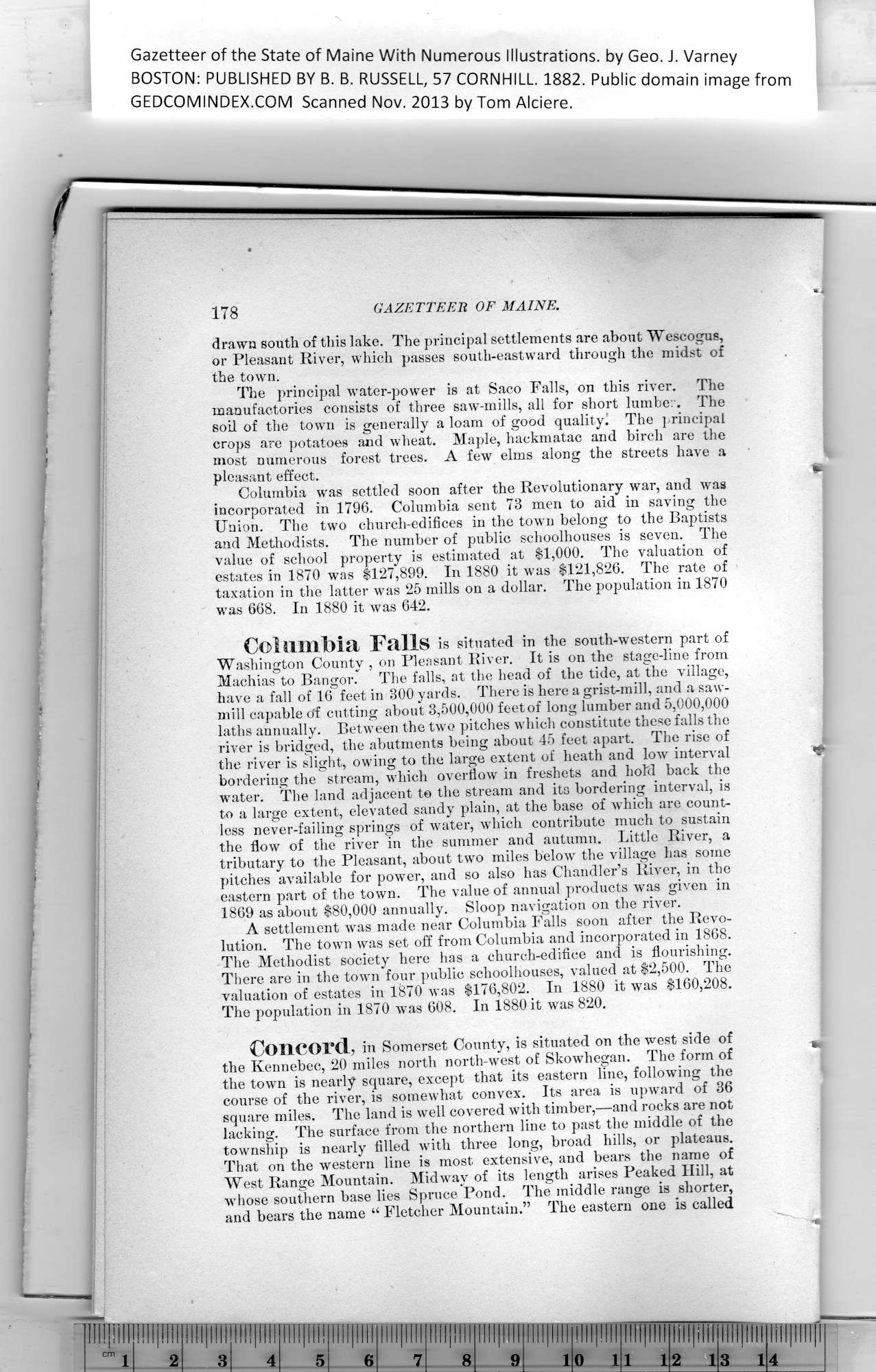|
Gazetteer of the State of Maine With Numerous Illustrations, by Geo. J. Varney
BOSTON: PUBLISHED BY B. B. RUSSELL, 57 CORNHILL. 1882. Public domain image from
drawn south of this lake. The principal settlements are about Wescogus,
or Pleasant River, which passes south-eastward through the midst of
the town.
The principal water-power is at Saco Falls, on this river. Tbe
manufactories consists of three saw-mills, all for short lumber. The
soil of the town is generally a loam of good quality.* The principal
crops are potatoes and wheat. Maple, hackmatac and birch are the
most numerous forest trees. A few elms along the streets have a
pleasant effect.
Columbia was settled soon after the Revolutionary war, and was
incorporated in 1796. Columbia sent 73 men to aid in saving the
Union. The two church-edifices in the town belong to the Baptists
and Methodists. The number of public schoolhouses is seven. The
value of school property is estimated at $1,000. The valuation of
estates in 1870 was $127,899. In 1880 it was $121,826. The rate of
taxation in the latter was 25 mills on a dollar. The population in 1870
was 668. In 1880 it was 642.
Columbia Falls is situated in the south-wmstern part of
Washington County , on Pleasant River. It is on the stage-line from
Machias to Bangor. The falls, at the head of the tide, at the village,
have a fall of 16 feet in 300 yards. There is here a grist-mill, and a saw-
mill capable of cutting about 3,500,000 feet of long lumber and 5,000,000
laths annually. Between the two pitches which constitute these falls the
river is bridged, the abutments being about 45 feet apart. The rise of
the river is slight, owing to the large extent of heath and low interval
bordering the stream, which overflow in freshets and hold back the
water. The land adjacent to the stream and its bordering interval, is
to a large extent, elevated sandy plain, at the base of which are count-
less never-failing springs of water, which contribute much to sustain
the flow of the river in the summer and autumn. Little River, a
tributary to the Pleasant, ahout two miles below the village has some
pitches available for power, and so also has Chandler’s River, in the
eastern part of the town. The value of annual products was given in
1869 as about $80,000 annually. Sloop navigation on the river.
A settlement was made near Columbia Falls soon after the Revo-
lution. The town was set off from Columbia and incorporated in 1868.
The Methodist society here has a church-edifioe and is flourishing.
There are in the town four public schoolhouses, valued at $2,500. The
valuation of estates in 1870 was $176,802. In 1880 it was $160,208.
The population in 1870 was 608. In 1880 it was 820.
Concord, in Somerset County, is situated on the west side of
the Kennebec, 20 miles north north-west of Skowhegan. The form of
the town is nearly square, except that its eastern line, following the
course of the river, is somewhat convex. Its area is upward of 36
square miles. The land is well covered with timber,—and rocks are not
lacking. The surface from the northern line to past the middle of the
township is nearly filled with three long, broad hills, or plateaus.
That on the western line is most extensive, and bears the name of
West Range Mountain. Midway of its length arises Peaked Hill, at
whose southern base lies Spruce Pond. The middle range is shorter,
and bears the name “ Fletcher Mountain.” The eastern one is called
PREVIOUS PAGE ... NEXT PAGE
This page was written in HTML using a program written in Python 3.2
|
